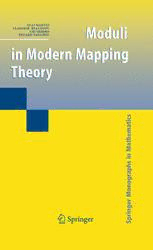Table Of ContentSpringer Monographs in Mathematics
Forothertitlespublishedinthisseries,goto
http://www.springer.com/series/3733
Olli Martio Vladimir Ryazanov Uri Srebro
• • •
Eduard Yakubov
Moduli in Modern
Mapping Theory
With 12 Illustrations
123
OlliMartio VladimirRyazanov
UniversityofHelsinki InstituteofAppliedMathematics
Helsinki andMechanicsofNationalAcademy
Finland ofSciencesofUkraine
olli.martio@helsinki.fi Donetsk
Ukraine
[email protected]
UriSrebro EduardYakubov
Technion-IsraelInstitute H.I.T.-HolonInstituteofTechnology
ofTechnology Holon
Haifa Israel
Israel [email protected]
[email protected]
ISSN:1439-7382
ISBN:978-0-387-85586-8 e-ISBN:978-0-387-85588-2
DOI10.1007/978-0-387-85588-2
LibraryofCongressControlNumber:2008939873
(cid:2)c SpringerScience+BusinessMedia,LLC2009
Allrightsreserved.Thisworkmaynotbetranslatedorcopiedinwholeorinpartwithoutthewritten
permissionofthepublisher(SpringerScience+BusinessMedia,LLC,233SpringStreet,NewYork,NY
10013,USA),exceptforbriefexcerptsinconnectionwithreviewsorscholarlyanalysis.Useinconnec-
tionwithanyformofinformationstorageandretrieval,electronicadaptation,computersoftware,orby
similarordissimilarmethodologynowknownorhereafterdevelopedisforbidden.
Theuseinthispublicationoftradenames,trademarks,servicemarks,andsimilarterms,eveniftheyare
notidentifiedassuch,isnottobetakenasanexpressionofopinionastowhetherornottheyaresubject
toproprietaryrights.
Printedonacid-freepaper
springer.com
Dedicatedto100YearsofLarsAhlfors
Preface
The purpose of this book is to present modern developments and applications of
thetechniquesofmodulusorextremallengthofpathfamiliesinthestudyofmap-
pings in Rn, n≥2, and in metric spaces. The modulus method was initiated by
Lars Ahlfors and Arne Beurling to study conformal mappings. Later this method
was extended and enhanced by several other authors. The techniques are geomet-
ricand have turned out tobe an indispensable tool in the study of quasiconformal
and quasiregular mappings as well as their generalizations. The book is based on
ratherrecentresearchpapersandextendsthemodulusmethodbeyondtheclassical
applicationsofthemodulustechniquespresentedinmanymonographs.
Helsinki O.Martio
Donetsk V.Ryazanov
Haifa U.Srebro
Holon E.Yakubov
2007
Contents
1 IntroductionandNotation ...................................... 1
2 ModuliandCapacity ........................................... 7
2.1 Introduction ............................................... 7
2.2 ModuliinMetricSpaces..................................... 7
2.3 ConformalModulus ........................................ 11
2.4 GeometricDefinitionforQuasiconformality .................... 13
2.5 ModulusEstimates ......................................... 14
2.6 UpperGradientsandACCpFunctions ......................... 17
2.7 ACC FunctionsinRnandCapacity........................... 21
p
2.8 LinearDilatation ........................................... 25
2.9 AnalyticDefinitionforQuasiconformality...................... 31
2.10 RnasaLoewnerSpace...................................... 34
2.11 Quasisymmetry ............................................ 40
3 ModuliandDomains ........................................... 47
3.1 Introduction ............................................... 47
3.2 QEDExceptionalSets ...................................... 48
3.3 QEDDomainsandTheirProperties ........................... 52
3.4 UniformandQuasicircleDomains ............................ 55
3.5 ExtensionofQuasiconformalandQuasi-IsometricMaps.......... 62
3.6 ExtensionofLocalQuasi-Isometries .......................... 69
3.7 QuasicircleDomainsandConformalMappings ................. 71
3.8 OnWeaklyFlatandStronglyAccessibleBoundaries............. 73
4 Q-HomeomorphismswithQ∈L1 ............................... 81
loc
4.1 Introduction ............................................... 81
4.2 ExamplesofQ-homeomorphisms ............................. 82
4.3 Differentiabilityand K (x,f)≤C Qn−1(x) a.e. ................ 83
O n
4.4 AbsoluteContinuityonLinesandW1,1 ........................ 86
loc
4.5 LowerEstimateofDistortion................................. 89
x Contents
4.6 RemovalofSingularities .................................... 90
4.7 BoundaryBehavior ......................................... 91
4.8 MappingProblems ......................................... 92
5 Q-homeomorphismswithQinBMO ............................. 93
5.1 Introduction ............................................... 93
5.2 MainLemmaonBMO ...................................... 94
5.3 UpperEstimateofDistortion................................. 96
5.4 RemovalofIsolatedSingularities ............................. 97
5.5 OnBoundaryCorrespondence................................ 97
5.6 MappingProblems ......................................... 99
5.7 SomeExamples............................................101
6 MoreGeneralQ-Homeomorphisms ..............................103
6.1 Introduction ...............................................103
6.2 LemmaonFiniteMeanOscillation............................104
6.3 OnSuperQ-Homeomorphisms ...............................108
6.4 RemovalofIsolatedSingularities .............................109
6.5 TopologicalLemmas........................................114
6.6 OnSingularSetsofLengthZero..............................118
6.7 MainLemmaonExtensiontoBoundary .......................121
6.8 ConsequencesforQuasiextremalDistanceDomains .............123
6.9 OnSingularNullSetsforExtremalDistances...................125
6.10 ApplicationstoMappingsinSobolevClasses ...................126
7 RingQ-Homeomorphisms.......................................131
7.1 Introduction ...............................................131
7.2 OnNormalFamiliesofMapsinMetricSpaces..................132
7.3 CharacterizationofRingQ-Homeomorphisms ..................135
7.4 EstimatesofDistortion......................................137
7.5 OnNormalFamiliesofRingQ-Homeomorphisms...............141
7.6 OnStrongRingQ-Homeomorphisms..........................142
8 MappingswithFiniteLengthDistortion(FLD) ....................145
8.1 Introduction ...............................................145
8.2 ModuliofCuttingsandExtensiveModuli ......................147
8.3 FMDMappings ............................................149
8.4 FLDMappings ............................................152
8.5 UniquenessTheorem .......................................154
8.6 FLDandQ-Mappings.......................................156
8.7 OnFLDHomeomorphisms ..................................159
8.8 OnSemicontinuityofOuterDilatations ........................164
8.9 OnConvergenceofMatrixDilatations .........................169
8.10 ExamplesandSubclasses....................................172
Contents xi
9 LowerQ-Homeomorphisms .....................................175
9.1 Introduction ...............................................175
9.2 OnModuliofFamiliesofSurfaces ............................176
9.3 CharacterizationofLowerQ-Homeomorphisms.................180
9.4 EstimatesofDistortion......................................183
9.5 RemovalofIsolatedSingularities .............................184
9.6 OnContinuousExtensiontoBoundaryPoints...................185
9.7 OnOneCorollaryforQEDDomains ..........................186
9.8 OnSingularNullSetsforExtremalDistances...................186
9.9 LemmaonClusterSets......................................187
9.10 OnHomeomorphicExtensionstoBoundaries ...................190
10 MappingswithFiniteAreaDistortion ............................193
10.1 Introduction ...............................................193
10.2 UpperEstimatesofModuli ..................................194
10.3 OnLowerEstimatesofModuli ...............................198
10.4 Removalofisolatedsingularities..............................199
10.5 ExtensiontoBoundaries.....................................200
10.6 FinitelyBi-LipschitzMappings...............................202
11 OnRingSolutionsoftheBeltramiEquation.......................205
11.1 Introduction ...............................................205
11.2 FiniteMeanOscillation .....................................207
11.3 RingQ-HomeomorphismsinthePlane ........................211
11.4 DistortionEstimates ........................................216
11.5 GeneralExistenceLemmaandItsCorollaries...................224
11.6 Representation,FactorizationandUniquenessTheorems..........228
11.7 Examples .................................................232
12 HomeomorphismswithFiniteMeanDilatations ...................237
12.1 Introduction ...............................................237
12.2 MeanInnerandOuterDilatations .............................239
12.3 OnDistortionof p-Moduli...................................242
12.4 ModuliofSurfaceFamiliesDominatedbySetFunctions .........244
12.5 AlternateCharacterizationsofClassicalMappings...............247
12.6 Mappings(α,β)-QuasiconformalintheMean ..................249
12.7 CoefficientsofQuasiconformalityofRingDomains .............251
13 OnMappingTheoryinMetricSpaces ............................257
13.1 Introduction ...............................................257
13.2 ConnectednessinTopologicalSpaces..........................259
13.3 OnWeaklyFlatandStronglyAccessibleBoundaries.............262
13.4 OnFiniteMeanOscillationWithRespecttoMeasure ............263
13.5 OnContinuousExtensiontoBoundaries .......................267
13.6 OnExtendingInverseMappingstoBoundaries..................270
13.7 OnHomeomorphicExtensiontoBoundaries....................271
xii Contents
13.8 OnModuliofFamiliesofPathsPassingThroughPoint ..........272
13.9 OnWeaklyFlatSpaces .....................................274
13.10OnQuasiextremalDistanceDomains .........................277
13.11OnNullSetsforExtremalDistance...........................280
13.12OnContinuousExtensiontoIsolatedSingularPoints ............283
13.13OnConformalandQuasiconformalMappings ..................288
A ModuliTheory.................................................291
A.1 OnSomeResultsbyGehring.................................291
A.2 TheInequalitiesbyMartio–Rickman–Va¨isa¨la¨...................301
A.3 TheHesseEquality .........................................304
A.4 TheShlykEquality .........................................317
A.5 TheModulibyFuglede .....................................324
A.6 TheZiemerEquality........................................331
B BMOFunctionsbyJohn–Nirenberg..............................345
References.........................................................351
Index .............................................................365
Chapter 1
Introduction and Notation
Mapping theory started in the 18th century. Beltrami, Caratheodory, Christoffel,
Gauss,Hilbert,Liouville,Poincare´,Riemann,Schwarz,andsoonalllefttheirmarks
inthistheory.Conformalmappingsandtheirapplicationstopotentialtheory,math-
ematicalphysics,Riemannsurfaces,andtechnologyplayedakeyroleinthisdevel-
opment.
During the late 1920s and early 1930s, Gro¨tzsch, Lavrentiev, and Morrey in-
troduced a more general and less rigid class of mappings that were later named
quasiconformal.Verysoonquasiconformalmappingswereappliedtoclassicalprob-
lemslikethecovering ofRiemann surfaces(Ahlfors),themoduliproblemofRie-
mann surfaces (Teichmu¨ller), and the classification problem for simply connected
Riemann surfaces (Volkovyski). Quasiconformal mappings were later defined in
higher dimensions (Lavrentiev, Gehring, Va¨isa¨la¨) and were further extended to
quasiregularmappings(Reshetnyak,Martio,Rickman,andVa¨isa¨la¨).Thequasireg-
ularmappingsneednotbeinjectiveandinmanyaspectsaresimilartoanalyticfunc-
tions.Themonographs[1,22,36,110,176,187,190,256,260,315,316,327–329]give
acomprehensiveaccountoftheaforementionedtheoryanditsmorerecentachieve-
ments.
Recentlygeneralizationsofquasiconformalmappings,mappingsoffinitedistor-
tion,havebeenstudiedintensively;see,e.g.,thepapers[19,45,46,54,79,111,115–
117,124,132,133,145,147–149,153–156,195,196,231–233,237,248–251] and
themonograph[134].Quasisymmetryhasanaturalinterpretationinmetricspaces
andquasiconformalityfromamoreanalyticpointofviewhasalsobeenstudiedin
thesespaces;see,e.g.,[21,33,107,112,201,312].Thesetheoriescanbeappliedto
mappings in the Carnot and Heisenberg groups; see, e.g., [108,109,166,167,197,
199,221,238,314,324–326].
The method of themodulus of apath family,or equivalently themethod ofex-
tremal length, which was initiated by Ahlfors and Beurling in [5] for the study of
conformal mapping, is one of the main tools in the theory of quasiconformal and
quasiregularmappings.Theconformalmoduluscanbeusedtodefinequasiconfor-
malmappingsintheplaneandinspace.Ithasalsobeenemployedinmetricmeasure
O.Martioetal.,ModuliinModernMappingTheory,SpringerMonographsinMathematics,
DOI10.1007/978-0-387-85588-2 1,(cid:2)c SpringerScience+BusinessMedia,LLC2009

